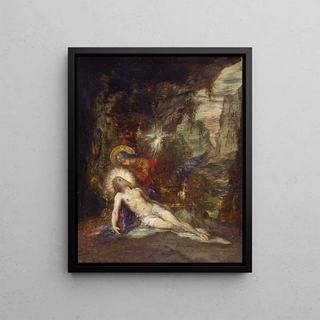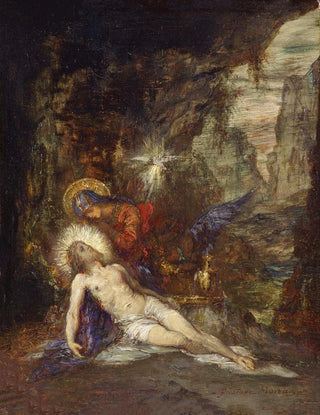Art print | Piétà - Gustave Moreau


View from behind

Frame (optional)
Reproduction Piétà - Gustave Moreau – Engaging Introduction
The "Piétà" by Gustave Moreau is a work that transcends the simple frame of painting to immerse the viewer in a universe that is both spiritual and emotional. This poignant depiction of the Virgin Mary holding the body of the dead Christ is a profound exploration of suffering, faith, and the beauty of sacrifice. Moreau, known for his symbolist style, manages to capture the essence of a tragic moment while infusing it with a mystical dimension. The light, colors, and shapes intertwine to create an atmosphere that is both serene and tragic, inviting the gaze to linger on every detail, every nuance.
Style and uniqueness of the work
What sets Moreau's "Piétà" apart is his unique approach to representing religious figures. The artist does not simply adhere to an iconographic tradition but reinvents the scene with a rich and complex visual language. The vibrant colors, often characterized by golden hues and deep blues, give the artwork a singular luminosity that enhances the intensity of the emotions. The stylized forms of the characters, as well as their delicate expressions, demonstrate technical mastery and artistic sensitivity that draw the viewer into deep contemplation. The background, often blurred and ethereal, reinforces this spiritual dimension, creating a separation between the material world and the divine realm. Through this work, Moreau does not merely depict a biblical scene; he invites reflection on pain and redemption.
The artist and his influence
Gustave Moreau, an emblematic figure of French symbolism, knew how to mark his era with an innovative approach to painting. His work reflects a personal quest, exploring themes of mythology, religion, and esotericism. Influenced by Renaissance masters as well as contemporary currents, Moreau developed a style that is uniquely his own, blending dream and reality. His technique, both meticulous and daring, has inspired many artists, both of his time and subsequent generations. As a professor at the École des beaux-arts de Paris

Matte finish

View from behind

Frame (optional)
Reproduction Piétà - Gustave Moreau – Engaging Introduction
The "Piétà" by Gustave Moreau is a work that transcends the simple frame of painting to immerse the viewer in a universe that is both spiritual and emotional. This poignant depiction of the Virgin Mary holding the body of the dead Christ is a profound exploration of suffering, faith, and the beauty of sacrifice. Moreau, known for his symbolist style, manages to capture the essence of a tragic moment while infusing it with a mystical dimension. The light, colors, and shapes intertwine to create an atmosphere that is both serene and tragic, inviting the gaze to linger on every detail, every nuance.
Style and uniqueness of the work
What sets Moreau's "Piétà" apart is his unique approach to representing religious figures. The artist does not simply adhere to an iconographic tradition but reinvents the scene with a rich and complex visual language. The vibrant colors, often characterized by golden hues and deep blues, give the artwork a singular luminosity that enhances the intensity of the emotions. The stylized forms of the characters, as well as their delicate expressions, demonstrate technical mastery and artistic sensitivity that draw the viewer into deep contemplation. The background, often blurred and ethereal, reinforces this spiritual dimension, creating a separation between the material world and the divine realm. Through this work, Moreau does not merely depict a biblical scene; he invites reflection on pain and redemption.
The artist and his influence
Gustave Moreau, an emblematic figure of French symbolism, knew how to mark his era with an innovative approach to painting. His work reflects a personal quest, exploring themes of mythology, religion, and esotericism. Influenced by Renaissance masters as well as contemporary currents, Moreau developed a style that is uniquely his own, blending dream and reality. His technique, both meticulous and daring, has inspired many artists, both of his time and subsequent generations. As a professor at the École des beaux-arts de Paris






